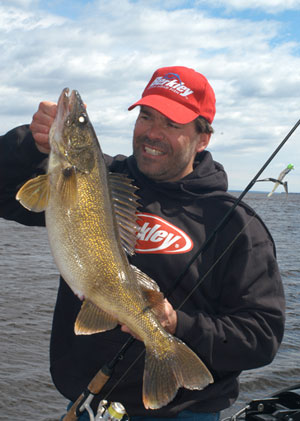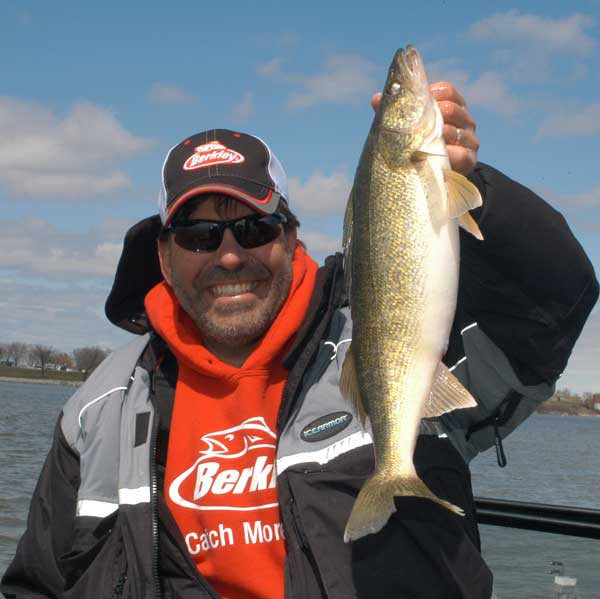This is one of the most anticipated events of the season to walleye anglers … that first venture out on open water in several months. The rivers are flowing, the walleyes are staging for their spring spawning ritual, and anglers are more than ready to drop their jigs in the water and do battle with their favorite fish. There’s an anxiety spurred by the feeling that this first outing could set the stage for the upcoming season, so success is a high priority. There have been countless hours of preparation the past few weeks … organizing tackle, re-spooling reels, and sharpening hooks. The only remaining question is, will you be prepared to drive home that first hookset?
This has been one of the toughest winters on record for a large part of the country, and not just the northern reaches. Snow and record low temps have everyone ready for spring and some fun outdoor activities. This seems especially true of the vast majority of walleye anglers out there, and luckily the time is here for the first really good open water action of the season. It’s time for the Spring River Walleye bite!
 This is one of the most anticipated events of the season to walleye anglers … that first venture out on open water in several months. The rivers are flowing, the walleyes are staging for their spring spawning ritual, and anglers are more than ready to drop their jigs in the water and do battle with their favorite fish. There’s an anxiety spurred by the feeling that this first outing could set the stage for the upcoming season, so success is a high priority. There have been countless hours of preparation the past few weeks … organizing tackle, re-spooling reels, and sharpening hooks. The only remaining question is, will you be prepared to drive home that first hookset?
This is one of the most anticipated events of the season to walleye anglers … that first venture out on open water in several months. The rivers are flowing, the walleyes are staging for their spring spawning ritual, and anglers are more than ready to drop their jigs in the water and do battle with their favorite fish. There’s an anxiety spurred by the feeling that this first outing could set the stage for the upcoming season, so success is a high priority. There have been countless hours of preparation the past few weeks … organizing tackle, re-spooling reels, and sharpening hooks. The only remaining question is, will you be prepared to drive home that first hookset?
It’s an often overlooked aspect of a walleye angler’s game-plan, but when it comes to vertical jigging, a quick hookset is one of those things that separates the good anglers from the great ones. Three major factors need to be addressed when it comes to improving your hook setting skills: 1) Understanding how a walleye bites, 2) Sensitivity in your presentation, and 3) Reaction to the bite.
It’s important to know how a walleye feeds in order to understand what’s happening to your jig when a fish bites. Picture the walleyes sitting at the head of a hole just off the main channel in your favorite river. They’re holding just below the lip, out of the main current flow, watching for a potential meal to float by. As your jig comes within the fish’s strike zone, he approaches it, opens his mouth and flares his gills. This creates a suction-like effect that pulls the jig into his mouth. As quickly as the jig was taken in, the walleye decides if what he’s just inhaled is food or foe. If foe, he exhales the offering at the same instant that you’re thinking to yourself “Was that a hit, or was that just the bottom?” The old adage, “Snooze and you lose” describes what has just happened to you. You missed the bite.
By understanding how the walleye takes your bait, you can do a few things to improve your chances of getting hooked up next time. The key is to “allow the bite to happen”. Using as light a jig as possible is the first step. A lighter jig will be easier for the fish to inhale; therefore you’ve got a better chance that the bait and the hook will get fully into the fish’s mouth. Jig size will be determined mostly by what size you can keep vertical and on the bottom in the current and wind conditions you’re faced with. In most cases, 1/8th to 3/8th ounces will cover most your vertical jigging situations. If you feel a heavier jig is needed, or if you’re still missing bites, you may need to add a stinger hook to your jig.
The action you impart on the jig will also have a bearing on whether or not you’re allowing the bite to happen. Especially in the spring, a slow “lift – pause – drop” jigging action is a good one to use. The walleyes are relating to the bottom, so keep the “lift” to a minimum … usually about 6 inches. Most of the bites will come on the “pause” or the “drop”. Occasionally a more aggressive “Pop and Drop” action will trigger more strikes. Here, you simply allow the jig to touch bottom, drop your rod tip a couple inches, then with a snap of the wrist, pop the jig off the bottom (again only 6 inches), hold it, and then lower it back down.

Factor two, sensitivity, is important for obvious reasons … if you don’t feel the bite, you’ll never know when to set the hook. This is where your choice of equipment plays a big role. No-stretch Berkley FireLine has made a lot of anglers better jig fishermen. The most popular line size is 6/2 (6 pound test, 2 pound diameter), with 4/1 FireLine being a good choice in really clear water or when a super finesse presentation is called for. Using no-stretch line calls for having the right rod. Since there’s no give in the line, the rod must act as the “shock-absorber” for fighting the fish once it’s hooked. That calls for a softer action tip section, but the rod still needs to be sensitive and have a strong backbone to help feel the bites and drive the hooks home. The Bass Pro Shops Walleye Angler Signature Series Jig Rod model WA60ML-HM85 is a 6 foot medium light action HM85 Graphite rod that’s perfect for jigging with FireLine.
You may not think about it, but boat control plays a big role in sensitivity also. Keeping the presentation vertical means you’re fishing with the least amount of line out, therefore you’ve got the most direct line to the fish. The goal is to drift the river the same speed as the current. The biggest problem to doing this is usually the wind. No matter if the wind is blowing up stream, downstream or cross-stream, point the bow into the wind, set the tolling motor speed on a higher setting, and use short, powerful bursts to quickly move the boat in order to keep the lines vertical. That way, as soon as the lines angle off to the left, a quick burst of power moving the boat to the left brings them back vertical again. By “following the lines” instead of trying to get the jigs to “follow the boat”, you’ll find it much easier to be successful at vertical jigging.
The final aspect of developing a faster hookset is reaction time. Honestly, this is one time when practice and time on the water are your best teachers. However, knowing that few of us get the time on the water we’d like, keep in mind the phrase, “when in doubt, set the hook.” That, combined with using the right gear and techniques will go a long way to helping you get your Next Bite.










